 |
|
Courtesy of the International Gay and Lesbian Review http://www.usc.edu/isd/archives/oneigla/onepress/ Changing Sex: Transsexualism, Technology, and the Idea of Gender by Bernice L. Hausman, Durham, North Carolina, Duke University Press, 1995, 245 pages, notes and index. Paper ISBN: 0822316927 Abstract
She includes a brief critique of the works of Marjorie Garber, Judith Shapiro, Teresa de Lauretis, and Janice Raymond. Chapter one, "Glands, Hormones, and Personality," introduces "the discursive apparatus of medical endocrinology." Hausman reminds us that science and "the social" are interconnected: "science depends upon, indeed is constituted by, an intimate relation to social institutions and beliefs" (25). She shows how sexologists divorced sexuality from psychology, linking it instead with "the glands of internal secretion" (30) and making it a medical rather than psychological disorder. Chapter two, "Plastic Ideologies and Plastic Transformations," focuses on the history of reconstructive genital surgery as applied first to those disfigured by nature, accident, or war and later to anyone requesting cosmetic surgical enhancement. Chapter three, "Managing Intersexuality and Producing Gender," details how sexologists, psychologists, and physicians have become "gender managers" who act to normalize the gender dysphoric. Hausman reveals how the gender managers began to "uphold binary gender by producing binary sex" by providing many examples from the medical literature, detailing several case studies and including photographs. Chapters four and five, "Demanding Subjectivity" and "Transsexual Autobiographies," consider the history outlined in the first part of the book through the perspectives of transsexuals themselves. Hausman shows that transsexuals have embraced Ulrich's notion of being "trapped" in the body of the "opposing" sex to facilitate their demand for surgical sex reassignment. Chapter six discusses the insights and limitations of gender theorists that have come before her--especially the work of Judith Butler and Thomas Lacquer. While acknowledging the relevance of those theorists, Hausman concludes by advocating a slightly different agenda: "I prefer the proliferations of sex to those of gender because the former category is more closely connected to the body than the latter" (180). The Epilogue reminds us that transsexuals can never truly become the "opposite" sex, no matter how convincingly they pass or how skilled the surgeon. Hausman is clear that she does not wish to portray transsexuals as victims of the medical establishment but rather in partnership with physicians in the drive to "depathologize transsexualism" and abandon "the stigma associated with psychiatric diagnosis" (199). She asserts "that the attempts at technological sex change do not achieve the changes desired" and suggests that we keep an eye out for a new breed of transsexual, one who settles for a partial sex change enacted through hormones. Review: ^Changing Sex~ True to its title, ^Changing Sex~ provides a valuable account of the modern history of transsexuality and the concept of gender. Hausman traces the influences of psychological, technological, and social ideologies on this burgeoning modern phenomenon. Her study contrasts the life histories of transsexuals to the theories of "specialists," providing a "subversive retelling" of the ongoing discourse between transsexuals and the medical establishment. Hausman raises many ethical questions regarding surgical sex-reassignment. At times, she points an accusatory finger toward opportunistic, profit-driven psychologists and surgeons: "Doctors, with ever increasing ability to intervene in and on the human body, to enact what are construed as miracles of the flesh, play out fantasies of the normal and the ideal" (65). However, she also illustrates how transsexuals are eager participants in the game, readily providing to psychologists the proper front to facilitate the desired diagnosis and resulting surgery. This she does through a chapter-length review of transsexual autobiographies.
Consequently, while the current trend in the humanities is to problematize the notion of binary gender roles or identities, Hausman's intent is to launch a critical attack on the notion of sex. As she puts it, "[m]aintaining an analytic distinction between sex and gender does not relegate 'sex' to the realm of scientific fact, but allows the critical thinker to make trouble in that very realm" (75). Hausman creates "trouble" by reminding us that the current conceptualization of gender does not problematize the false idea that there are genetically only two sexes. "[E]ndocrinology as science provided medicine with the tools to enforce sexual dimorphism-not only to examine and describe it" (38). "[T]hus it is technology that allows physicians to enforce binary gender through making males and females out of intersexuals" (77). Hausman raises many serious questions and caveats regarding the current gender- craze. Those of us who have found the term to be liberating and an adequate concept for ontological grounding will be forced to reconsider our comfort with the term. Congratulations to Hausman for providing this accessible and fascinating insight on a complex and generally misunderstood aspect of human nature. I highly recommend this book to students and gender theorists alike. While this book contains an index and copious endnotes, a bibliography would have been greatly appreciated by this reader. Todd White holds masters degrees in English and anthropology and is currently working toward his Ph.D. in social anthropology at the University of Southern California. 1998 review by C. Todd White |


 ^ Changing Sex: Transsexualism, Technology, and the Idea of Gender ~contains a brief preface and engaging introduction, six chapters, and an epilogue. In the introduction, Hausman proposes that "transsexuality is a category of experience and identity that can be read as a result of specific social and cultural conditions" (3).
^ Changing Sex: Transsexualism, Technology, and the Idea of Gender ~contains a brief preface and engaging introduction, six chapters, and an epilogue. In the introduction, Hausman proposes that "transsexuality is a category of experience and identity that can be read as a result of specific social and cultural conditions" (3).